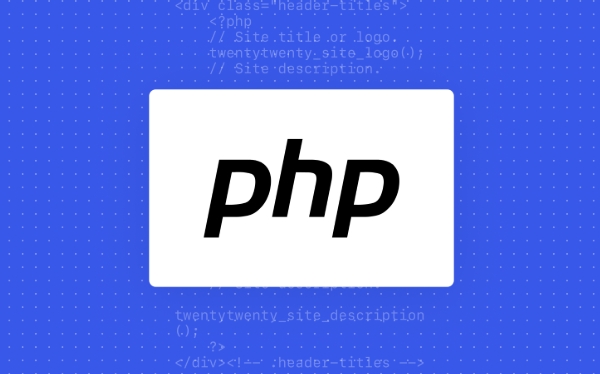To start a PHP session, you must first call the session_start() function, and it must be placed at the beginning of the script and before any output; secondly, store and retrieve data through the $_SESSION array, pay attention to check whether the variable exists and avoid storing sensitive information; finally, you must manually clear the $_SESSION array and call session_destroy() to delete the session cookies if necessary and redirect the user.

Starting a session in PHP is pretty straightforward, but there are a few key things to get right. The most important part is using the session_start() function — that's what actually kicks off the session. But where and how you use it matters, especially if you're dealing with login systems, shopping carts, or any kind of user tracking.

Where to put session_start()
You need to call session_start() at the very beginning of your script — before any output is sent to the browser. That means no HTML, no echo statements, not even a space or newline before the opening <?php tag.
If you try to start a session after sending output, PHP will throw an error like:

Warning: Cannot send session cache limiter - headers already sent
So always place session_start() at the top of your PHP file, like this:
<?php session_start(); // rest of your code here ?>
One exception: if you're including or requiring other files, make sure none of them generate output before session_start() runs.

How to store and retrieve session data
Once the session is started, you can store data in the $_SESSION superglobal array. This data persists across pages as long as the session is active.
For example, saving a username:
$_SESSION['username'] = 'john_doe';
Then on another page (as long as you call session_start() again), you can access it like:
echo 'Welcome back, ' . $_SESSION['username'];
Some common uses:
- Storing user IDs after login
- Keeping track of form inputs between steps
- Saving preferences temporary
A couple of things to remember:
- Only store necessary data — sessions can get heavy if overused
- Always check if a session variable exists before using it, like with
isset($_SESSION['key']) - Avoid storing sensitive information like passwords (use tokens or hashes instead)
Ending or destroying a session
Ending a session isn't just about closing the browser. If you want to log someone out or clear session data, you need to do a few things manually.
To destroy all session data:
session_start(); $_SESSION = array(); // clear all session variables session_destroy(); // end the session
Also, if you want to remove just one item:
unset($_SESSION['username']);
Keep in mind:
-
session_destroy()only removes the data on the server — it doesn't automatically unset the session cookie - To fully log someone out, you may also want to delete the session cookie
- Always redirect the user after logging them out to avoid confusion
Starting a session in PHP really comes down to three main points: calling session_start() early, managing $_SESSION carefully, and cleaning up when needed. It's simple enough once you know where to place things, but easy to mess up if you skip a step.
Basically that's it.
The above is the detailed content of How to start a session in PHP?. For more information, please follow other related articles on the PHP Chinese website!

Hot AI Tools

Undress AI Tool
Undress images for free

Undresser.AI Undress
AI-powered app for creating realistic nude photos

AI Clothes Remover
Online AI tool for removing clothes from photos.

Clothoff.io
AI clothes remover

Video Face Swap
Swap faces in any video effortlessly with our completely free AI face swap tool!

Hot Article

Hot Tools

Notepad++7.3.1
Easy-to-use and free code editor

SublimeText3 Chinese version
Chinese version, very easy to use

Zend Studio 13.0.1
Powerful PHP integrated development environment

Dreamweaver CS6
Visual web development tools

SublimeText3 Mac version
God-level code editing software (SublimeText3)

Hot Topics
 What are some best practices for versioning a PHP-based API?
Jun 14, 2025 am 12:27 AM
What are some best practices for versioning a PHP-based API?
Jun 14, 2025 am 12:27 AM
ToversionaPHP-basedAPIeffectively,useURL-basedversioningforclarityandeaseofrouting,separateversionedcodetoavoidconflicts,deprecateoldversionswithclearcommunication,andconsidercustomheadersonlywhennecessary.StartbyplacingtheversionintheURL(e.g.,/api/v
 How do I implement authentication and authorization in PHP?
Jun 20, 2025 am 01:03 AM
How do I implement authentication and authorization in PHP?
Jun 20, 2025 am 01:03 AM
TosecurelyhandleauthenticationandauthorizationinPHP,followthesesteps:1.Alwayshashpasswordswithpassword_hash()andverifyusingpassword_verify(),usepreparedstatementstopreventSQLinjection,andstoreuserdatain$_SESSIONafterlogin.2.Implementrole-basedaccessc
 What are weak references (WeakMap) in PHP, and when might they be useful?
Jun 14, 2025 am 12:25 AM
What are weak references (WeakMap) in PHP, and when might they be useful?
Jun 14, 2025 am 12:25 AM
PHPdoesnothaveabuilt-inWeakMapbutoffersWeakReferenceforsimilarfunctionality.1.WeakReferenceallowsholdingreferenceswithoutpreventinggarbagecollection.2.Itisusefulforcaching,eventlisteners,andmetadatawithoutaffectingobjectlifecycles.3.YoucansimulateaWe
 What are the differences between procedural and object-oriented programming paradigms in PHP?
Jun 14, 2025 am 12:25 AM
What are the differences between procedural and object-oriented programming paradigms in PHP?
Jun 14, 2025 am 12:25 AM
Proceduralandobject-orientedprogramming(OOP)inPHPdiffersignificantlyinstructure,reusability,anddatahandling.1.Proceduralprogrammingusesfunctionsorganizedsequentially,suitableforsmallscripts.2.OOPorganizescodeintoclassesandobjects,modelingreal-worlden
 How can you handle file uploads securely in PHP?
Jun 19, 2025 am 01:05 AM
How can you handle file uploads securely in PHP?
Jun 19, 2025 am 01:05 AM
To safely handle file uploads in PHP, the core is to verify file types, rename files, and restrict permissions. 1. Use finfo_file() to check the real MIME type, and only specific types such as image/jpeg are allowed; 2. Use uniqid() to generate random file names and store them in non-Web root directory; 3. Limit file size through php.ini and HTML forms, and set directory permissions to 0755; 4. Use ClamAV to scan malware to enhance security. These steps effectively prevent security vulnerabilities and ensure that the file upload process is safe and reliable.
 What are the differences between == (loose comparison) and === (strict comparison) in PHP?
Jun 19, 2025 am 01:07 AM
What are the differences between == (loose comparison) and === (strict comparison) in PHP?
Jun 19, 2025 am 01:07 AM
In PHP, the main difference between == and == is the strictness of type checking. ==Type conversion will be performed before comparison, for example, 5=="5" returns true, and ===Request that the value and type are the same before true will be returned, for example, 5==="5" returns false. In usage scenarios, === is more secure and should be used first, and == is only used when type conversion is required.
 How can you interact with NoSQL databases (e.g., MongoDB, Redis) from PHP?
Jun 19, 2025 am 01:07 AM
How can you interact with NoSQL databases (e.g., MongoDB, Redis) from PHP?
Jun 19, 2025 am 01:07 AM
Yes, PHP can interact with NoSQL databases like MongoDB and Redis through specific extensions or libraries. First, use the MongoDBPHP driver (installed through PECL or Composer) to create client instances and operate databases and collections, supporting insertion, query, aggregation and other operations; second, use the Predis library or phpredis extension to connect to Redis, perform key-value settings and acquisitions, and recommend phpredis for high-performance scenarios, while Predis is convenient for rapid deployment; both are suitable for production environments and are well-documented.
 How do I perform arithmetic operations in PHP ( , -, *, /, %)?
Jun 19, 2025 pm 05:13 PM
How do I perform arithmetic operations in PHP ( , -, *, /, %)?
Jun 19, 2025 pm 05:13 PM
The methods of using basic mathematical operations in PHP are as follows: 1. Addition signs support integers and floating-point numbers, and can also be used for variables. String numbers will be automatically converted but not recommended to dependencies; 2. Subtraction signs use - signs, variables are the same, and type conversion is also applicable; 3. Multiplication signs use * signs, which are suitable for numbers and similar strings; 4. Division uses / signs, which need to avoid dividing by zero, and note that the result may be floating-point numbers; 5. Taking the modulus signs can be used to judge odd and even numbers, and when processing negative numbers, the remainder signs are consistent with the dividend. The key to using these operators correctly is to ensure that the data types are clear and the boundary situation is handled well.






